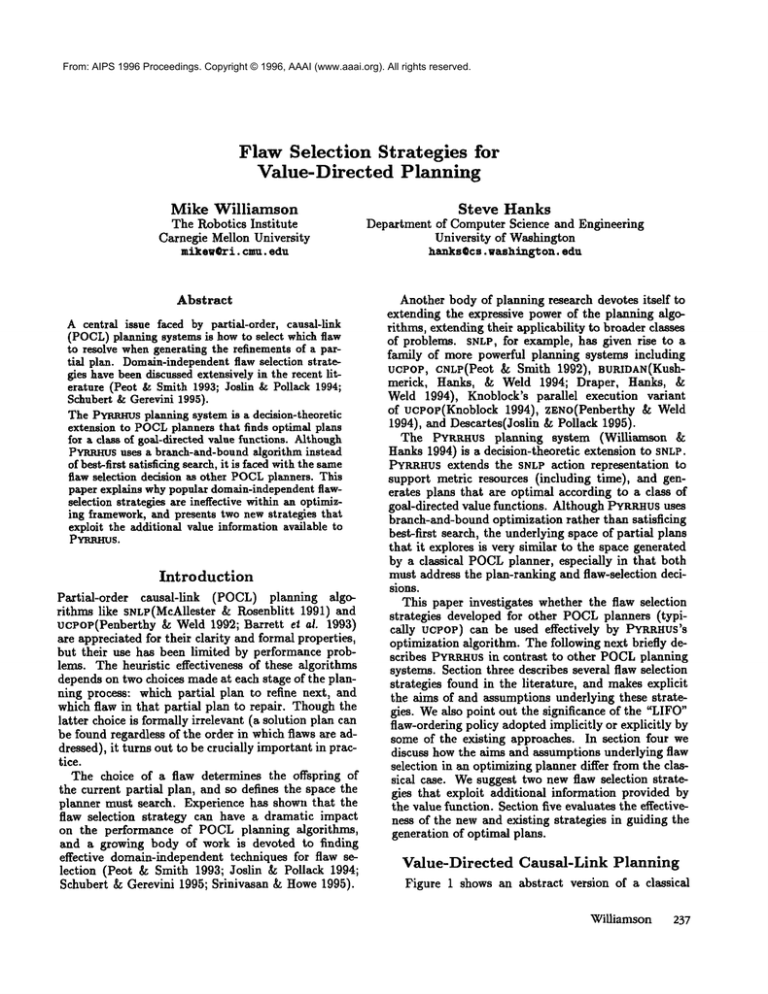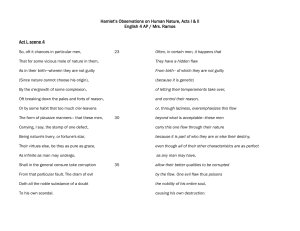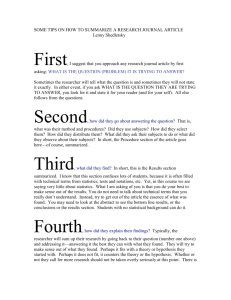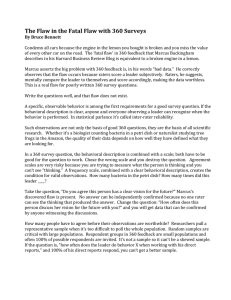
From: AIPS 1996 Proceedings. Copyright © 1996, AAAI (www.aaai.org). All rights reserved.
Flaw Selection Strategies for
Value-Directed
Planning
Mike Williamson
The Robotics Institute
Carnegie Mellon University
mikew@ri,cmu. edu
Abstract
A central issue faced by partial-order, cansal-link
(POCL)planning systems is howto select which flaw
to resolve whengenerating the refinements of a partial plan. Domain-independent
flaw selection strategies have beendiscussed extensively in the recent literature (Peot ~ Smith 1993; Joslin & Pollack 1994;
Schubert & Gerevini 1995).
The PYRRHUS
planning system is a decision-theoretic
extension to POCLplanners that finds optimal plans
for a class of goal-directed value functions. Although
PYRRHUS
uses a branch-and-bound algorithm instead
of best-first satisficing search, it is faced with the same
flaw selection decision as other POCLplanners. This
paper explains whypopular domain-independentflawselection strategies are ineffective within an optimizing framework, and presents two new strategies that
exploit the additional value information available to
PYaam~s.
Introduction
Partial-order
causal-link
(POCL) planning algorithms like SNLP(McAllester & Rosenblitt 1991) and
ucPop(Penberthy & Weld 1992; Barrett e1 ai. 1993)
are appreciated for their clarity and formal properties,
but their use has been limited by performance problems. The heuristic effectiveness of these algorithms
depends on two choices madeat each stage of the planning process: which partial plan to refine next, and
which flaw in that partial plan to repair. Thoughthe
latter choice is formally irrelevant (a solution plan can
be found regardless of the order in which flaws are addressed), it turns out to be crucially important in practice.
The choice of a flaw determines the offspring of
the current partial plan, and so defines the space the
planner must search. Experience has shown that the
flaw selection strategy can have a dramatic impact
on the performance of POCLplanning algorithms,
and a growing body of work is devoted to finding
effective domain-independent techniques for flaw selection (Peot & Smith 1993; Joslin & Pollack 1994;
Schubert & Gerevini 1995; Srinivasan & Howe1995).
Steve
Hanks
Department of Computer Science and Engineering
University of Washington
hanks@cs, washington, edu
Another body of planning research devotes itself to
extending the expressive power of the planning algorithms, extending their applicability to broader classes
of problems. SNLP, for example, has given rise to a
family of more powerful planning systems including
ucPoP, CNLP(Peot & Smith 1992), nURIDAN(Kushmerick, Hanks, & Weld 1994; Draper, Hanks, &
Weld 1994), Knoblock’s parallel execution variant
of ucpoP(Knoblock 1994), Z~.No(Penberthy & Weld
1994), and Descartes(Joslin & Pollack 1995).
The PYRRHUSplanning
system (Williamson
Hanks 1994) is a decision-theoretic extension to SNLP.
PYRRHUS extends the SNLPaction representation
to
support metric resources (including time), and generates plans that are optimal according to a class of
goal-directed value functions. Although PYRRHUS
uses
branch-and-bound optimization rather than satisficing
best-first search, the underlying space of partial plans
that it explores is very similar to the space generated
by a classical POCLplanner, especially in that both
must address the plan-ranking and flaw-selection decisions.
This paper investigates whether the flaw selection
strategies developed for other POCLplanners (typically ucpov) can be used effectively
by PYRRHUS’s
optimization algorithm. The following next briefly describesPYRRHUSin contrast
to otherPOCLplanning
systems.
Section
threedescribes
several
flawselection
strategies
foundin theliterature,
andmakesexplicit
theaimsof andassumptions
underlying
thesestrategies.We alsopointoutthesignificance
of the"LIFO"
flaw-ordering
policy
adopted
implicitly
orexplicitly
by
someof the existing
approaches.
In sectionfourwe
discuss
howthealmsandassumptions
underlying
flaw
selection in an optimizing planner differ from the classical case. Wesuggest two new flaw selection strategies that exploit additional information provided by
the value function. Section five evaluates the effectiveness of the new and existing strategies in guiding the
generation of optimal plans.
Value-Directed
Causal-Link
Planning
Figure 1 shows an abstract version of a classical
WiUiamson
237
From: AIPS 1996 Proceedings. Copyright © 1996, AAAI (www.aaai.org). All rights reserved.
Algorithm POCL( init, goal)
Let Horizon = { MakeInitialPlan(init, goal )
While Horizon is not empty do:
Choose a partial plan P from Horizon.
If P has no flaws then
Return P as a solution.
Else
Choose a flaw F from the partial plan P.
Add Refinements(P, F) to Itorizon.
l~turn failure.
Figure 1: An abstract goal-satisfying
rithm
planning algo-
goal-satisfying
POCLplanning algorithmJ The function MakelnitiaIPlan returns a partial plan with two
dummysteps encoding the goal and initial state. The
function Refinements takes a partial plan and a flaw,
and returns a set of new partial plans which represent
all possible ways of fixing the given flag’. A partial
plan can have two kind of flaws:
¯ Open conditions (a.k.a. "goals" or "sub-goals") are
preconditions of steps in the plan which the planner
has not yet made a commitment to achieving. They
are repaired by adding a causal link from some new
or existing step. Whena new step is added to the
plan, its preconditions becomenew open conditions.
¯ Threats (a.k.a. "unsafe links") axe possible violations of causal links by other steps in the plan. They
are repaired by adding step-ordering or variablebinding constraints.
Implementations of this abstract algorithm differ in
the way they make the choices of which partial plan
to refine and which flaw to repair. The plan to refine is typically chosen best-first according to a weak,
domain-independent heuristic measure such as the sum
of the number of steps and the number of flaws in the
partial plan. ~ The choice of flaw to repair will be discussed in detail below.
The PYRRHUS planning
algorithm
Figure 2 gives an abstract description of PYRRHUS.3
The primary difference between PYRRHUS
and a classical planning algorithm is in the formulation of the
problem itself. Instead of just being given a formula
1 The description of POCL
planning herein is necessarily
sketchy, omittingprecise definitions of partial plans, causal
links, threats, etc. The reader is referred to (Weld1994)
for a general introduction to the topic, or (Kambhampati,
Knoblock, & Yang1994) for a detailed discussion of the
manypossible variations on this basic algorithm.
2See (Schubert &Gerevini 1995) for a discussion of some
plan ranking heuristics of this kind.
3Again a cursory description. For more details see
(Williamson &Hanks 1994).
238 AIPS-96
Algorithm PYRRHUS( init, V)
Let incumbent = status quo (i.e. do nothing).
Let Horizon = { MakelnitialPlan( init, V)
While Horizon is not empty do:
Choose a partial plan P from Horizon.
If UB(V(P)) < ])(incumbent) then discard P.
Else
If P has no flaws and
LB(])( P) ) > ])(incumbent) then
Let incumbent = P.
Else Choose a flaw F of the plan P.
Add Refinements(P, F) to Horizon.
lLeturn incumbent.
Figure 2: An abstract description of the Pyrrhus planning algorithm
describing a goal to achieve, PYRRHUS
is given a goaldirected value function 4 (Haddawy & Hanks 1993).
This value function extends the traditional conception
of a goal to include additional information like temporal deadlines, preferences over situations in which the
goal is only partially satisfied, and the value associated
with satisfying the goal and the cost of the resources
required to do so.
PYRRHUS
finds an optimal plan with respect to the
value function by making tradeoffs between the importance of achieving the goal and the cost of resources
consumed in doing so. The value function provides a
rich, semantically grounded measure of plan quality.
Classical planning typically either makes the assumption that all plans satistying the goal are equipreferable, or uses an ad hoc and perhaps implicit measure
of quality such as the numberof steps in the plan. But
PYRR.HUS
i8 able to draw finer and more meaningful
distinctions between plans. In a delivery domain, for
example, the value function might lead PYRRHUS
to
produce a plan which makes a delivery 20 minutes late
instead of one which makes the delivery on time but
uses more fuel to do so. In some cases, the optimal
course of action might be to do nothing at all (maintain the status qno), and PYRRHUS
can often determine
this very quickly.
PYRRHUS
can use the value function to construct
the initial plan for a plan space including all plans
possibly preferable to the status quo. But the most
important feature of the value function is that it allows the calculation of bounds on the value of a partial
plan. If a partial plan has no flaws (is complete) its
precise value can be calculated. An incomplete partial
plan can be viewed as a compact representation of the
(possibly infinite) set of all complete plans that can
"~
4 "Valuefunctions" are different from~utility functions
because they directly encode preferences over outcomes
rather than preferences over lotteries over outcomes(see
(Keeney & Raiffa 1976)). P~Rm.TS
makes the classical
planning assumptionsabout certainty.
From: AIPS 1996 Proceedings. Copyright © 1996, AAAI (www.aaai.org). All rights reserved.
obtained by further refinement,and therefore the value
of a partial plan can be represented by an interval containing the values of all possible completions of that
plan. In general there will be no lower bound on the
value of an incomplete plan, since subsequent refinements might make the plan arbitrarily
bad. An upper
bound on value can be calculated by considering the
resources consumed by the plan so far and the greatest possible degree to which the plan might satisfy the
goal. Refinement of a partial plan partitions its possible completions amongthe offspring, so each offspring
must have an upper bound on value no greater than
its parent.
PYRRHUS’sbranch-and-bound
optimization
algorithmis muchlikethe refinement
searchprocedure
usedby POCLplanners.
Theybothexplorea spaceof
5 PYRRHUSlikepartialplanswithsimilarstructure.
wiseusesa best-first
strategy
forselecting
plansto
refine,
buttheranking
is basedon valueratherthan
simplestructural
characteristics.
Mostnotably,
both
arefacedwiththetaskof choosing
whichflawfrom
a givenpartialplanto useto refinethatplan.The
similarity
between
thechoices
facedby thetwoalgorithms
leadsus to hopethatflawselection
strategies
developed
forclassical
POCLplanners
mightbe useful
for PYRRHUS
as well.
Existing
Flaw Selection
Strategies
In this section we describe a numberof flaw selection
strategies found in the literature, formalize the aim
of these strategies, and expose certain underlying assumptions. Wealso discuss precondition-order sensitivity, an important aspect of flaw selection strategies
that has received little attention.
T/O-LIFO The published
SNLP and ucPoP algorithms resolve all threats before working on any open
conditions. Formally, the algorithms were described
nondeterministically and so were mute on the issue of
which particular threat or open condition to resolve.
In practice, the most widespread implementations of
these algorithms process both threats and open conditions in a LIFO manner. The LIFO aspect of this
strategy can have significant performance implications
(see below), although we suspect this strategy was
originally adopted more by accident than by design.
(This strategy has been referred to as ~SNLP"and
"UCPOF"in the literature.
We call it "T/O-LIFO"
to avoid confusion with other aspects of those algorithms, and to make the LIFOpolicy explicit.)
DUnf Peot and Smith (Peot & Smith 1993) examinethe question
of whetherthreats
shouldalwaysbe
SinPYRRHUSthedefinition
of openconditions
and
causal
linkshasbeengeneralized
to support
metric
resources
likefuellevel
aswellaslogical
propositions,
but
thatdifference
isnotrelevant
here.
resolved before open conditions, both from a theoretical and an experimental standpoint. They consider
various strategies for "delaying" certain threats, i.e.
choosing to resolve any existing open conditions before the postponed threats. One promising strategy
they develop is that of delaying "unforced" threats,
that is, those for which refinement leads to more than
one offspring.
With respect to open condition selection, they indicate that in their experiments they considered three
different strategies: LIFO, FIFO, and a "least-commitment" approach that selects open conditions in order
to minimize the number of offspring. However, they do
not provide detailed analysis of howthese various open
condition selection strategies affect performance. We
consider two of these variations on the "delay unforced
threats" strategy: DUnf-LIFOchooses open conditions
in LIFO order, while DUnf-LCOSchooses open conditions to achieve least commitment.
LCFlqt Joslin and Pollack (Joslin & Pollack 1994)
offer a closer examination and generalization of Peot
and Smith’s least-commitment strategy. Suggesting
that the benefit of DUnfderives from minimizing the
branching factor of the search space, they propose always choosing a flaw that minimizes the number of
offspring, regardless of the threat/open condition distinction. They call this strategy "least-cost flaw repair" (LCFR), and compare it experimentally to both
Dunf-LIFO and Dunf-LCOS as well as the original
T/O-LIFO strategy. They found that LCFRand DunfLCOSperformed much better than the other strategies
on manyproblems in a variety of domains.
ZLIFO Schubert and Gerevini (Schubert & Gerevini
1995) consider the question of open condition selection,
and propose a hybrid strategy. Their technique is to
first choose those open conditions which give rise to either zero or one offspring, which can be considered to
be "zero-commitment" or deductive decisions. If there
are no zero-commitment open conditions, then choose
from the remainder in LIFO order. They demonstrate
on problems from several domains that this ZLIFO
strategy is generally superior to T/O-LIFO.
Their discussion of other strategies is limited, but
they compare ZLIFO to LCFR on a few problems.
They report that the strategies perform comparably on
the easier problems, but that on the harder problems
(from the Towers of Hanoi domain), ZLIFO’s performance was considerably superior to LCFR.
Flaw selection:
aims and assumptions
Whydoes flaw selection play such an important role in
planning efficiency? A commonbelief is that judicious
flaw selection improves planner performance by reducing the size of the search space. But this isn’t quite
right; in most cases, the potential search space is infinitely large, regardless of the flaw selection strategy
Williamson 239
From: AIPS 1996 Proceedings. Copyright © 1996, AAAI (www.aaai.org). All rights reserved.
employed. Rather, judicious flaw selection improves
performance by reducing the size of the space seal~:hed.
This depends not only on the flaw selection strategy,
but also on the way the algorithm chooses partial plans
to refine.
Obviously the ultimate aim of a flaw selection policy is to minimize the expected future planning effort
required to find a solution plan. In POCLplanners,
the amount of effort is directly related to the number
of partial plans that must be generated and evaluated
before a solution is found. The flaw selection policy
determines both the minimum depth (number of refinements) at which a solution plan can be found as
well as the total numberof partial plans (nodes in the
search tree) up to that depth. If this tree were searched
breadth-first by numberof refinements, all the nodes at
the solution depth or above would have to be searched.
Lacking the ability to predict how flaw choice affects
solution depth, a reasonable heuristic for minimizing
the total number of nodes would bc to favor the [law
with the least number of direct offspring, thus minimizing the tree’s immediate branching factor.
In fact, the best-first
search used by many POCL
planners can be viewed as "approximately" breadthfirst in that the standard ranking flmctions simply tend
to favor plans with fewer commitments, thus explaining the effectiveness of fewest-offspring strategies such
as ZLIFO and LCFR.
Precondition-order
sensitivity
In light of the above analysis, we were puzzled by the
reported dramatic superiority of of ZLIFOto LCFR.
Since the two heuristics agree on which flaw to select
when the branching factor is less than two, the improvement must derive from cases where the "IJIFO"
part of ZLIFOselects a flaw with higher branching factor than LCFRwould choose. Whyis this LIFO flaw
selection beneficial?
Regarding LIFO, Schubert and Gerevini suggest
that,
Based on experience with search processes in AI in
general, such a strategy has much to recommend
it, as a simple default. It will tend to maintain
focus on the achievement of a particular higherlevel goal by regression ... rather than attempting
to achieve multiple goals in breadth first fashion.
(Schubert & Gerevini 1995.. p. 9)
While this comment about the regression-oriented
character of LIFOsearch strategies is undoubtedly correct, it misses the mark with respect to POCLplanning. The true value of LIFOflaw sclection ~ is that
it allows the introduction of domain-specific flaw selection policies into the planning process. Thc order in
which new open conditions are resolved will depend not
just on the order that steps are added to the plan, but
eAt least with respect to the widely available UCPOP
implementation.
240 AIPS-96
far more significantly, on the order in which preconditions are specified in the operator description. This
precondition-order sensitivity (POS) can have an overwhelmingeffect on performance.
To demonstrate the precondition-order sensitivity of
ZLIFO,we created six versions of the single-operator
Towers of Ilanoi domain (T-of-H1) used by Schubert and Gerevini. These domains differ only in the
permutation of the three main preconditions of the
7move-d£sk operator.
Running UCPOPwith ZLIFO
on the three disk problem in each of these six domains
resulted in greatly varying numbersof plans explored,
as shownin Table 1.
This experiment clearly shows that the performance
of ZLIFO(like any other strategy which employs LIFO
flaw selection) dependscrucially on the ordering of preconditions in the operator descriptions. The strong
performance of ZLIFO (in that domain formulation
where its performance is strong) is more properly ascribed to the domain-specific flaw selection knowledge
encoded in the operator descriptions than to ZLIFO
itself. It would be unfair to compare such results to
the performance of a flaw selection strategy that did
not exhibit such precondition-order sensitivity.
Weargue that precondition-order sensitivity is a serious shortcoming of the LIFO-based flaw selection
stratcgies. It scverely undermines the process of engineering domain knowledge, since the putatively declarative domain descriptions can have such an impact
on tractability.
If one does believe that search control information should be encoded in the domain
description, then it should be done through explicit
and well-defined mechanismssuch as filter precondit,ions or other condition types (Currie & "rate 1991;
Collins & Pryor 1992; Tate, Drabble, & Dalton 1994).
Eliminating precondition-order sensitivity can be
difficult,
though, since many strategies (including
LCFR)underspecify the choice of flaw. In practice the
decision must somehowbc made, but the performance
of most naive deterministic methods like LIFOwill be
sensitive to the order in which operator preconditions
are declarcd.
Value-directed
Flaw Selection
Wenow turn to the problem of flaw selection in the
context of PYRRIIUS:soptimizing planning algorithm.
As in goal-satisfying planning the overall aim of flaw
selcction is to minimize the amountof search required
to find a solution, but in the optimization case the
means to this end are different.
Whereas the goalsatisfying algorithm can stop whenit finds a successful plan, PYRRHUS
must at least implicitly consider
the entire search space. On the other hand, the goalsatisfying algorithm cannot eliminate a partial plan
from consideration until it is proven to be infeasible,
but thc optimizing algorithm can eliminate a partial
rWealso used the S+OCplan selection heuristic.
From: AIPS 1996 Proceedings. Copyright © 1996, AAAI (www.aaai.org). All rights reserved.
Order of
preconditions
(on ?disk ?below-disk)
(clear ?disk)
clear ?new-below-disk)
on ?disk ?below-disk)
(clear ?new-below-disk)
clear ?disk)
clear ?disk)
(on ?disk ?below-disk)
(clear ?new-below-disk)
Table 1: Planning difficulty
Nodes ]]
explored
186
1834
7816
Order of
preconditions
(clear ?new-below-disk)
(on ?disk ?below-disk)
(clear ?disk)
(clear ?disk)
(clear ?new-below-disk)
(on ?disk ?below-disk)
(clear ?new-below-disk)
(clear ?disk)
(on ?disk ?below-disk)
Nodes
explored
29046
100000+
100000+
for ZLIFOon variations of the T-of-tfl domain.
plan as soon as the upper bound on its value is lower
than the value of the incumbent (see Figure 2).
Thus, PYgRHUS’seffectiveness is improved by increasing the rate at which partial plans are pruned,
which can be accomplished in two ways:
1. Quickly find a better incumbent. This corresponds roughly to goal-satisfying planning, and
is achieved by trying to reduce the size of the
search space leading to a complete feasible plan.
Wemight thus expect existing strategies such as
LCFRto be effective in this regard.
2. Generate partial plans with tighter upper bounds.
The choice of flaw can improve the quality of value
bounds over the offspring, allowing them to be
pruned earlier. This approach has no real analogue in classical planning.
The problem is that these two approaches tend to conflict. Often, better bounds on the value of a partial
plan are obtained by making exactly the kinds of commitments that a strategy such as LCFRtries to avoid.
As an illustration of this point, consider the simplified drive operator from the Tmckworld (Hanks, Pollack, & Cohen 1993) domain (Figure 3). The amount
fuel consumed by a drive action is determined by the
function fuel-consumed-function, which is called during the planning process with the current bindings of
the parameters of the operator. If any of the parameters are unbound (because of commitments not yet
made in the planning process), then this function returns an interval providing upper and lower bounds on
the change in fuel level.
Now, imagine that some partial
plan contains
the partially instantiated step (drive ?from Paris
?speed). Consequently, the plan would also contain
at least the two open conditions (road-connecting
?from Paris) and (speed ?speed). These could
both be closed by making links to the initial state.
Resolving the former flaw might cause ?from to be
boundto one of {Berlin,Vienna,Rome, Madrid,
Moscow},while resolving the latter would cause ?speed
to be bound to one of {Slow, Fast}. LCFRwould
prefer to resolve the latter flaw, since it generates
fewer offspring. But from the standpoint of branchand-bound optimization, resolving the former flaw is
much more important. Knowing where you are driving from allows calculation of a much tighter bound
on the amount of fuel consumed, and consequently a
better upper bound on the value of each resulting partial plan. In short, the choice of flaw affects not only
the branching factor of the search space, but also the
amount of knowledge one has about the value of a partial plan.
Strategies
for improving
value bounds
Wewould like to develop flaw selection strategies that
generate partial plans with better upper bounds on
value. But it’s not clear what "better" means, since
resolving a flaw can result in manyoffspring, each with
its own upper bound on value. Consider Figure 4 which
shows a partial plan P1 with two flaws F1 and F2, each
giving rise to two offspring. The numbersare the upper
bounds on value for each partial plan.
Which flaw will lead to the most future pruning if
it is repaired next? Westart only with the supposition that the value of the incumbent will increase as
the refinement process proceeds and better complete
plans are found. One intuition suggests that flaw F1
would be preferable: since the bound on its highest
offspring is lower than the bound on F2’s highest offspring, all of Fl’s offspring could be pruned earlier.
But another line of reasoning suggests F2: although
the offspring with a bound of 0.7 will be pruned later
than either of the offspring generated by F1, the other
offspring (with a bound of 0.2) will be pruned much
earlier. Since deciding between these two alternatives
would require additional (and unavailable) information
about how the incumbent’s bound might improve, we
developed the following two flaw selection strategies
and compared them empirically.
LUBVIf one advantage to refining a partial plan is
that doing so can improve upper bounds on the vab
ues of the offspring, then an obvious heuristic to consider is choosing the flaw that gives the most such imWiUiamson
241
From: AIPS 1996 Proceedings. Copyright © 1996, AAAI (www.aaai.org). All rights reserved.
(operator(drive?from 7to ?speed)
:precondition
(:and (truck-at7from)
(road-connecting ?from ?to)
(speed ?speed))
:duration duration-function
:resources ((fuel-level
:precondition
fue~reqnired-fnnction
: change fue~consumed-function))
:effect (:and (:not (truck-at ?from))
(truck-at
?to)))
Figure 3: The drive operator from the Truckworld domain.
P1 UB=0.9
Resolve F1
I
Im
[
Resolve F2
UB=0.6 [
Figure 4: The effect of flaw choice on upper bounds on value
provement. The "least upper bound on value" (LUBV)
strategy chooses a flaw such that the maximumupper
bound on value over its offspring is minimized. This
stragegy would choose flaw F1 in the above example.
Oneinterpretation of this strategy is that it favors the
flaw whose repair gives the greatest increase in knowledge of the value of the partial plan.
SUBV LCFR. and LUBV can be seen as two extremes. While the former tries only to minimize
branching factor, the latter tries only to maximizeimprovement of value bounds. The "sum of uppcr bounds
on value" (SUBV)strategy strikes a balance between
these two extremes, choosing the flaw that minimizes
the sum of the upper bounds on value over the plan’s
offspring. Whereas LUBVconsiders only the single
offspring with maximumvalue bound, and LCFRconsiders only the numberof offspring.. SUBV
can be interpreted as a count of the number of offspring weighted
by their value bounds. SUBVwould favor flaw F2 in
the above example.
Empirical
evaluation
Weimplemented the five existing and two new flaw
selection strategies described above in PYRRIIUSand
evaluated them on a collection of problems drawn
from a transportation planning domain inspired by the
Truckworld simulator(Itanks, Pollack, & Cohen 1993}.
These problems involved delivering cargo between multiple origins and destinations with varying partiallysatisfiable (soft) deadlines. There were four operators
242 AIPS-96
in the domain, and the world consisted of six locations
intcrconnected by seven roads. The planner had to
reason about whcre fuel was available, which routes to
take, howfast to drive, and even which deliveries were
worth making. T~adeoffs existed between the amount
of fuel consumed, the amount of moneyspent (on toll
roads), and the degree to which the deadlines were met.
Sohltion plans varied in length from no steps (in cases
where the status qno was optimal), to 8 steps.
Our first experiment tested the existing strategies on
ssomeclassical goal-satisfying problems in this domain,
As researchers have found in other domains, LCFR,
ZLIFO, and DUnf-LCOSall strongly outperformed
T/O-LIFO, with LCFRproviding the best overall performance. This experiment suggested that LCFRis a
good general heuristic for goal-satisfying planning in
this domain.
Our main experiment was to evaluate all seven
strategies on a suite of 20 optimization problems. A
search limit of 10000 partial plans was imposed. Figure 5 shows the number of partial plans explored by
9five of the flaw selection strategies on each problem.
The problems are shown ordered roughly according to
s PYRRHUS
can perform both goal-satisfying and valueoptimizing planning. In the former role it functions much
like ucPoP, but with extensions to handle time and metric
resources.
9The performance of DUnf-LCOS
was uniformly very
close to LCFR, and the performance of DUnf-LIFOwas
similarly close to T/O-LIFO.The two DUnfstrategies are
therefore omitted.
From: AIPS 1996 Proceedings. Copyright © 1996, AAAI (www.aaai.org). All rights reserved.
difficulty for the SUBVstrategy. Note that the horizontal axis of the graph contains 20 discrete problems
rather than a continuous progression; the lines in the
graph are only an aid to visualization.
The strategies that worked hardest to reduce commitment (i.e. minimize branching factor), LCFRand
DUnf-LCOS,performed the worst on most problems.
The strongly LIFO oriented strategies,
T/O-LIFO,
ZLIFO, and DUnf-LIFO exhibited better performance
on most problems, but as described above, this is due
to flaw selection knowledge encoded in the operator
descriptions (which had been hand-tuned for acceptable performance under T/O-LIFO during their development). The best overall performance was obtained
by SUBV.By explicitly working both to minimize the
branching factor and to maximize improvement of the
bounds on partial plan value, SUBVdominated all
other strategies.
Some final experimentation was performed to evaluate the precondition-order sensitivity of the SUBV
strategy, since it uses LIFOto break (infrequent) ties
between flaws. Wedeveloped an alternative version,
SUBV-R,which chooses randomly between tied flaws
and so completely avoids precondition-order sensitivity. SUBV-Rwas used to solve each problem ten times.
It exhibited little variance between runs on each problem. In no case was the performance of SUBVsignificantly different from the mean performance of SUBVR, thus indicating that SUBVis deriving no benefit
from precondition ordering.
Absolute performance In practice, the benefit of
more sophisticated flaw selection strategies is diminished by the additional computation required in selecting flaws. In our experiments SUBVrequired about
1°
40 times as much CPUtime per node as T/O-LIFO.
This overhead is related linearly to the average number
of flaws per plan. But as Peot and Smith point out,
on harder problems this cost will be dominated by the
reduction in the number of plans explored. Our experiments reinforce that conclusion, with SUBVeffectively
solving problems that were beyond the reach of other
strategies. Joslin and Pollack present an approximation to their LCFRstrategy which obtains comparable
results at a much lower per node overhead. A similar
approximation technique might be used for SUBV.
Conclusion
This paper has investigated the problem of flaw selection as it arises in PYRRHUS,
an optimizing planner, in contrast to goal-satisfying POCLplanning algorithms. Wehave described how the optimization
algorithm places different demands on a flaw selection strategy. This analysis led to the development of
1°Whichis approximately the same computational overhead noted by ~oslin and Pollack (3oslin &Pollack 1994)
for LCFR.
SUBV,a powerful new flaw selection strategy for valuedirected planning. Wehave also pointed out that the
performance of manyexisting flaw-selection strategies
is highly sensitive to the ordering of operator preconditions; the absence of a domain-independent theory
of how to order these preconditions compromises the
claim that these strageties are in fact domainindependent.
Acknowledgements
This work was funded in part by a NASAGraduate
Research Fellowship and by NSF grant IRI-9008670.
Many thanks to Dan Weld, Marc Friedman and Neal
Lesh for constructive feedback on this work.
References
Barrett, A.; Golden, K.; Penberthy, J.; and Weld, D.
1993. UCPOPuser’s manual, (version 2.0). Technical
Report 93-09-06, University of Washington, Department of Computer Science and Engineering. Available
via FTP from pub/ai/at ftp. cs. washington, edu.
Collins, G., and Pryor, L. 1992. Achieving the functionality of filter conditions in a partial order planner.
In Proc. lOth Nat. Conf. on A.I.
Currie, K., and Tate, A. 1991. O-plan: the open
planning architecture. ArtificialIntelligence 52(1):4986.
Draper, D.; Hanks, S.; and Weld, D. 1994. Probabilistic planning with information gathering and contingent execution. In Proc. 2nd Intl. Conf. on A.I.
Planning Systems.
Haddawy,P., and Hanks, S. 1993. Utility Models for
Goal-Directed Decision-Theoretic Planners. Technical Report 93-06-04, Univ. of Washington, Dept. of
Computer Science and Engineering. Submitted to Artificial Intelligence. Available via FTP from pub/ai/
at ftp. cs. washington, edu.
Hanks, S.; Pollack, M. E.; and Cohen, P. R. 1993.
Benchmarks, testbeds, controlled experimentation,
and the design of agent architectures.
AI Magazine
14(4).
Joslin, D., and Pollack, M. 1994. Least-cost flaw
repair: A plan refinement strategy for partial-order
planning. In Proc. l~th Nat. Conf. on A.L
Joslin, D., and Pollack, M. 1995. Passive and active
decision postponement in plan generation. In Proceedings of fhe Third European Workshop on Planning.
Kambhampati, S.; Knoblock, C.; and Yang, Q. 1994.
Planning as refinement search: A unified framework
for evaluating design tradeoffs in partial order planning. Department of Computer Science and Engineering TR-94-002, Arizona State University. To appear
in Artificial Intelligence Special Issue on Planning and
Scheduling.
Keeney, R. L., and ILaiffa, H. 1976. Decisions with
Multiple Objectives: Preferences and Value Tradeoffs.
WiUiamson
243
From: AIPS 1996 Proceedings. Copyright © 1996, AAAI (www.aaai.org). All rights reserved.
I0000
I VWl-/
/!
:-
I
o
°
a
]~iX
/-
1000
0
[]
;
:x,.
::
.x:.
s : .....
<..~.......
~,"
"..
~:
’~
~ .... 4: ,,."
"
. , .....
F ,+/.: ~’..’4¯
."
/
;
,"
’.
; t"
.
. ; :
.,....
¯:.,¯
... #
~... ,,:, / /)(: ...... )(4,
,
/i!
I~.~"
I¢ /x
/~~-’."’
¯ .c-----g~:
;i
¯.~
"’.
....’/ "~’.¯
...
’,",,- "....’
";, ,./ .....
"o
:’. ."
.’
: ~
i [..."
’.".-
}
,"
a,.....
~ .....
*¢
.,.,,.---";
.-.".*"
100
~j,l:~’
[
ZLIFO--I--T/O-LIFO-E3-LUBV
..M
.....
SUBV-~-’-
~’---,r
/
,i
!
".&._._.~(
f
10
0
I
5
Figure 5: Performance of various strategies
explored)
15
I
20
on optimization problems (search truncated at 10000 partial
John Wiley and Sons. Republished in 1993 by Cambridge University Press.
Knoblock, C. 1994. Gcnerating parallel execution
plans with a partial-order planner. In Proc. "2nd Intl.
Conf. on A.L Planning Systems, 98-103.
Kushmerick, N.; Hanks, S.; and Weld, D. 1994. An
Algorithm for Probabilistic Least-Commitment Planning. In Proc. l~th Nat. Conf. on A.I.
McAllester, D., and Rosenblitt, D. 1991. Systematic
nonlinear planning. In Proc. 9th Nat. Conf. on A.I.,
634-639.
Penberthy, J., and Vqeld, D. 1992. UCPOP:A sound,
complete, partial order planner for ADL. ht Proc.
3rd Int. Conf. on Principles of KnowledgeRepresentation and Reasoning, 103-114. Available via FTP
from pub/ai/at ftp.on.washington,
edu.
Penberthy, J., and Weld, D. 1994. Temporal planning
with continuous change. In Proc. l~th Nat. Conf. on
A.L
Peot, M., and Smith, D. 1992. Conditional Nonlinear
Planning. In Proc. 1st Intl. Conf. on A.L Planning
Systems, 189-197.
Peot, M., and Smith, D. 1993. Threat-removal strategies for partial-order planning. In P1w’. 111h Nat.
Conf. on A.L, 492-499.
Schubert, L., and Gerevini, A. 1995. Accelerating partial order planners by improving plan and
244 AIPS-96
#
10
Problem number
plans
goal choices. Technical Report 570, University of
Rochester, Dept. of Computer Sciencc.
Srinivasan, R., and Howe, A. 1995. Comparison of
rncthods for improving search efficiency in a partialorder planner. In Proceedings of the l~th International Conference on AL
Tare, A.; Drabble, B.; and Dalton, J. 1994. The use
of condition types to restrict search in aa ai planner.
In Proceedings of the Twelfth National Conference on
A1.
Weld, D. 1994. An introduction to least-comnaitment
planning. A1 Magazine 27--61. Available via FTP
from pub/ai/at
ftp.ca. washington,
edu.
Williamson, M., and Hanks, S. 1994. Optimal planning with a goal-directed utility model. In Proc. ~nd
1nil. Conf. on A.I. Planning Systems.







